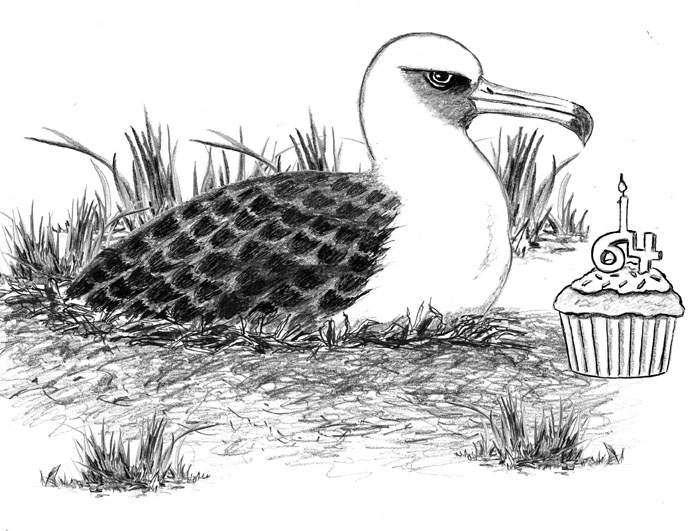
Dear Bird Folks,
My friend in New Hampshire sent me this story about the oldest living wild bird and I thought you might like it.
– Sarah, Cambridge, MA
Me, too, Sarah,
Thanks for the bird article, but I also have friends in New Hampshire and they sent me the same story, and it’s an interesting one. We can always count on NH for the important things in life. In addition to bird stories, New Hampshire provides us with nice hiking trails and great skiing, plus fireworks and cheap booze. Now that’s what I call a good neighbor.
The bird everyone in New Hampshire is getting excited about is an albatross named, “Wisdom.” Typically, long-lived birds are found in zoos where they are routinely checked by veterinarians and receive lots of TLC. But Wisdom is a wild bird, living in the middle of the Pacific Ocean and a long way from any vets or TLC. How old is Wisdom? Because albatross parents rarely keep accurate birth records, scientists can only guesstimate the bird’s age. They believe Wisdom hatched in 1951, way back in the “I like Ike” days. This means Wisdom is at least sixty-four and will soon be eligible for Medicare (plus, endless amounts of annoying junk mail from AARP).
Specifically, Wisdom is a Laysan Albatross from the Midway Atoll National Wildlife Refuge, a tiny spit of land that sits about 1,200 miles northwest of Honolulu. Laysan Albatross are named after the nearby bird-rich island of Laysan. Though small by albatross standards, these seabirds still have an impressive seven-foot wingspan, which makes them masters of the air, but a bit awkward on land. Unlike songbirds, albatross aren’t in a hurry to start cranking out the kids. They don’t even attempt to nest until they are around five years old and even then will only lay one single egg per season. After their egg is laid, the couple will take turns incubating it for the next two months…two long, boring months.
BTW: Laysan (the island) is also home to the Laysan Duck, a bird that was nearly wiped out by, of all things, rabbits. In 1912, introduced rabbits obliterated the island’s vegetation, which in turn decimated the duck population. At one sad point there were only seven adult Laysan Ducks left alive in the entire world and things looked bleak. But the dopey rabbits also forgot to leave some plants for themselves to eat, so when the last of vegetation was gone, the ravenous rabbits quickly starved. This allowed the Laysan Duck population to gradually rebound. (The ducks vs. the bunnies story is okay to tell most of the year, but I wouldn’t bring it up at Easter.)
When the baby albatross finally hatches, it will spend the next four months begging for food from its parents. What does it eat, you ask? Baby albatross are fed a regurgitated substance called “stomach oil.” I don’t know what that is and I hope I never find out. Actually, I’m kind of wishing I didn’t even have to write it. Adult Laysan Albatross mostly feed on squid that they grab just below the surface of the ocean. Because secure breeding grounds (islands that are free of predators or evil rabbits) aren’t always near a food source, the adults must fly great distances to find squid for the kid. (Hmm, “Find squid for the kid.” I think I just discovered my new bumper sticker.) In some cases an adult may make a round trip of over 3,000 miles just to find enough food. Can you imagine, 3,000 miles? Have these parents never heard of Domino’s?
As I said earlier, what is most impressive about Wisdom’s longevity is that this is a totally wild bird, spending 100% of its life exposed to the elements. Albatross are constantly being battered by storms, while at the same time trying to avoid oils spills, or ingesting floating plastic, or worse, eating food from Chipotle. Plus, albatross aren’t just sitting on the beach all day, soaking up the sun. It is said that each year a Laysan Albatross will fly an average of 50,000 miles. Thus, in its sixty-four years of life, Wisdom has likely flown close to three million miles and has possibly logged more air miles than any other creature on earth…except for maybe Santa’s reindeer.
On a different topic:
There are two months of the year when we can expect our feeders to be quiet. One is June, when most of the birds are nesting and feeding on insects; the other time is now, in December. Many birds (grackles) have gone south and the mild weather has left an abundance of natural food that the remaining birds are taking advantage of. But just like last winter, this will all change when the nasty weather arrives. In the meantime, just be patient, enjoy the holidays, and try to get the image of “stomach oil” out of your head.